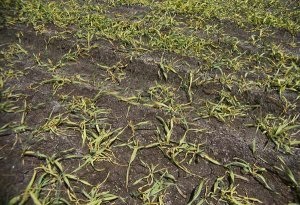Cover crops: barley
Information on the benefits and growth habits of barley planted as a cover crop.
Description

Family
- Grass
- Barley interseeded on much for wind protection has already been sprayed. Note the prostrate growth habit (low to the ground).
Growth habits
Top growth
- Fast growing annual grass
- Growth habit is less upright than oats
- Tillers more than oats
- Can grow 20 to 50 cm in the fall
- Full term barley can reach 60 to 120 cm
Root System
- Fibrous root system — not as aggressive as rye
- Reaches 1.8 to 2.1 m in depth
Overwintering
- Does not overwinter in cold winters as seedlings die at - 8°C
- However, cold tolerance increases as the plant matures — winterkill is not always consistent in mild winters
- Winter barley tolerance is inconsistent and may result in patchy stands
Site suitability
- Grows best in cool dry conditions, less tolerant of wet soils than oats
- Requires less soil moisture for optimum growth
- Preferred soil pH is greater than 6.0
- Barley has a very high salt tolerance
Control options
- Winterkill
- Herbicides
- Cultivation
Sensitivity to herbicides: weed control
- Usually not needed if solid stand established
- There are many herbicides registered for use in barley but good weed control for a cover crop should not be expensive and may not be needed.
- Establish a vigorous crop canopy to smother out weeds.
Benefits and concerns
Nutrient management
- Does not absorb as much nitrogen as rye
- When it winterkills, nitrogen is released during decomposition
Pest management
- Very competitive crop - more than oats
- With aggressive tillering — will suppress weeds
Organic matter
- If planted early enough in the fall there will be sufficient biomass to increase soil organic levels
- Research suggests that barley crops will form a more stable seedbed structure than alfalfa
Erosion control
- Cold tolerance — makes it a sound choice for early spring wind and water erosion control protection
- Suitable for solid stand or for wind strips
- As with oats — can be planted prior to or with precision planted cool season vegetable crops such as carrots, radish or onions for early wind erosion and wind damage protection as they emerge on sandy or muck soils
- Barley is not as suitable as rye as wind strips in tomatoes — due to slower height growth
As feed
- Commonly grown as feed and bedding crop or cover crop
Getting started
Establishment
- Performs best under cool moist conditions
Cost and availability
- Seed is easily available
- Relatively inexpensive
Updated: May 28, 2024
Published: June 01, 2022